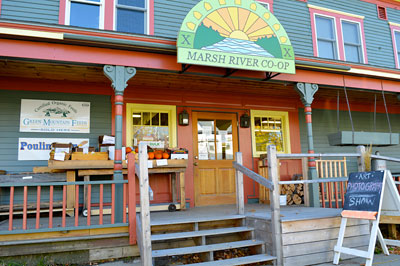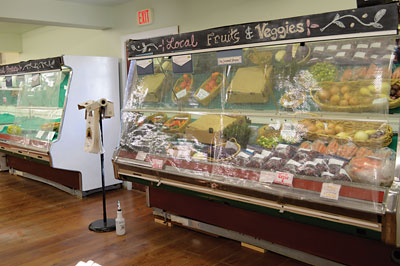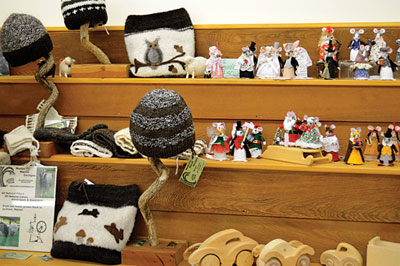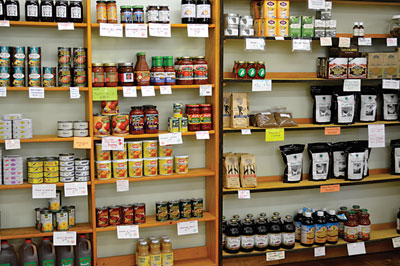 |
| The Marsh River Food Coop, near the intersection of Routes 7 and 139 in Brooks, offers local products whenever possible. English photos |
 |
| Local produce on display in late October |
New Member and Producer Coop is a Model for Other Coops
By Jon Walsh
Set amid a series of low, forested hills, Brooks, Maine, has long billed itself as the “Heart of Waldo County.” The town served from its founding as a supply and processing hub for farmers in the surrounding countryside. In the second half of the 20th century, however, local agriculture began to decline, and many farm-related businesses shut down. The recent growth in small organic farms and homesteads in Brooks has inspired a group of motivated farmers and community members to begin taking steps to revive the agricultural economy there. One of these steps was opening the Marsh River Coop in August 2014.
Located in the center of town, on the corner of Routes 7 and 139, the new coop occupies a commercial building that formerly housed a hardware store. The building is owned by board member Izzy McKay, who donates the space to the coop.
The exterior of the coop resembles an old fashioned country store, with a long wooden porch, boxes filled with apples and other produce, and locally produced seedlings in season. The traditional exterior is matched by the interior decor, but the products on display reflect a more progressive orientation. Glass door coolers lining one wall are filled with locally produced dairy products, Maine-grown and -milled flours, and eggs. Others contain seasonal produce grown within 10-miles of the store. The chest freezer contains sustainably raised beef, chicken, fish and pork, as well as ice cream and locally frozen vegetables. Baked goods from Ralph’s Cafe, Coastal Baking Company, and Back 40 Baking Company are also available along with coffee from nearby roasters.
A small section of spices, canned and dry goods and condiments reflects the desire to make the coop a place where customers can meet all their food needs. These products are complemented by an array of fine crafts produced by community members. In the rear corner is a supply depot for small farmers, stocked with organic livestock feed, electric fence materials and other goods. The space also includes a furnished cafe area and a small community library filled with books about sustainable agriculture.
In the center of this bounty of quality foods and other goods, an island-like checkout area holds a rack of organic seeds, chocolates and other sundry items. Often this counter is staffed by Ed Hamel, a founding member of the Marsh River Coop. Passionate about the organization, Hamel thrives on interacting with customers, sharing the story and mission of the coop and providing a welcoming atmosphere to all visitors. He is a great source of information about the organization’s short history.
 |
| A small section of the café area with the art show featured in October |
 |
| Locally made crafts |
“The coop actually started out as a weekly farmers’ market,” Hamel explains. “About three years ago, a few of the vendors started thinking about the possibility of creating a more permanent space for selling local products.” The idea of a permanent coop in Brooks, however, was not motivated by commercial interests alone. As plans developed, one important factor was a desire to support local access to food and other vital resources free from dependence on petroleum-based global transportation systems. Another was to create a stronger and more self-sufficient local community. With these goals in mind, the founders envisioned a supply hub for the community selling food and goods produced within 10 miles. By aggregating products from a truly local area, this hub would enable the community to meet most of its own needs without relying on outside inputs or even motorized transport. With many local farms producing dairy products, meat, vegetables and eggs, and local processors creating bread, condiments, dried herbs and other necessities, the founders saw the Brooks area as capable of feeding itself in a relatively closed system. As Hamel points out, “Less than 100 years ago, towns like Brooks were producing most of their own food, and really, they ate pretty well. Foods were just more seasonal.”
In seeking to achieve this goal of local self-sufficiency while benefiting farmers and other producers, the founders developed a cooperative business model. In general, coops are business entities designed to provide various mutual benefits to their members depending on the type of coop. Consumer coops, for example, often buy supplies or food in bulk to ensure low prices and product variety for their members. Producer coops, on the other hand, are organized by farmers and focus on aggregating, distributing and collectively marketing agricultural products to ensure fair treatment, market opportunities and good prices.
While consumer food coops selling natural and organic foods are perhaps the most widely known type of cooperative in the United States, producer coops play a much larger role in the national economy. Benefiting from their scale, large producer coops market and distribute a large percentage of all commodity crops and agricultural supplies. Despite this important role in conventional agriculture, the producer coop model is still fairly unusual in the local and organic food sectors – in part because food distribution networks are still almost entirely oriented toward large-scale commodity production. While conventional producer cooperatives can pool their products easily and sell into the global food system, small food producers who do not wish to participate in this system have no choice but to market their produce at the individual farm level. Without an effective local foods aggregation and distribution network, small farmers are thus forced to compete directly with nearby producers rather than working together to market their products.
The Marsh River Coop is a pioneering member of a new movement of producer coops seeking to change this reality by creating more localized opportunities for the collective marketing of non-commodity farm products. Unlike traditional producer coops, it is made up of both producer and consumer members. Both types of members are required to invest an equity payment upon joining, which is used for the capital needs of the business. The decision-making process is democratic, with each member given an equal vote in electing an eight-member board of directors each September. While consumer members are eligible to be on the board, at least half of the seats are reserved for producer members in keeping with the mission to focus on the needs of local farmers, processors and craftspeople.
 |
| Some shoppers find everything they need at the coop. |
With this objective in mind, the Marsh River Coop provides a variety of services to its producer members. These include money-saving bulk purchases of farm inputs and livestock feed, democratic governance, and prioritizing local products for sale in the store. To ensure the highest possible proportion of local goods, the organization uses a tiered approach in selecting which products to sell. Priority goes to items produced by the core group of founding members, followed by all producer members located within 10 miles of the coop. If a desired product cannot be sourced from coop members, the board will try to purchase from nonmember farms within 10-miles. If this is impossible (for goods such as chocolate, coffee and certain packaged items), the coop will turn to external suppliers. This purchasing model ensures the maximum opportunity for the largest number of local producers to get their products to market.
In exchange for these benefits, producer members are expected to volunteer 12 hours a month staffing the store during business hours (10-6 Wednesday through Saturday, 10-5 on Sunday). This requirement eliminates the need for paid staff and greatly reduces operating costs. It also ensures that producers continue to develop direct relationships with their customers while enjoying the time-saving benefits of having a permanent retail home for their products. While the coop is focused on meeting the needs of producers, it also welcomes community members to join the organization as consumer members, entitling them to a 5 percent discount on all items in the store and a say in coop decisions. Consumer members who also volunteer 12 hours a month receive an additional 10 percent discount.
The Marsh River Coop also provides services to the community as a whole, in keeping with its mission to serve as a hub for improving local awareness, resiliency and self-reliance. To this end, the coop offers free community events, including a well attended monthly open mike night, store-based art gallery openings, MOFGA fundraisers and educational roundtable discussions on various local farming topics.
While the fledgling organization is barely a year old, it has already developed a core group of regular customers drawn by the promise of buying truly local food. Developing this customer base has taken time, as people from surrounding towns and even as far as Belfast have slowly heard of the coop and come to investigate. As Hamel explains, “When we first started and for quite a while, what we would have would be individuals who would come and buy just one or two things. Now we are transitioning to more people who are coming in and doing their grocery shopping.” He even mentions a few customers who “are not going anywhere except here.” Because the coop is not in the business of selling prepared or processed foods, these core customers tend to be the type to prepare their own food from basic ingredients. For such customers a central location from which to purchase produce from a variety of local farmers provides an ideal food purchasing experience even without the variety of a conventional supermarket or larger coop grocery.
Since its founding, the coop has continued to grow slowly. While the organizers have had to overcome some obstacles between the inception of the idea and the end of its first year, in true cooperative spirit they have not had to do it alone. Hamel is quick to point out the contributions of other cooperatives and local businesses to the success of the store. The two large dairy coolers along one wall, for example, were donated by the Belfast Coop, while much of the shelving came from Barrels Community Market in Waterville. All chairs and tables in the cafe were donated, as well, from nearby Fair Haven Camps. As Hamel says, in general “coops help other coops.” This spirit of cooperation among different businesses that might otherwise see themselves as competing is a big part of what has helped the Marsh River Coop and other food coops grow and gain momentum in their communities.
If the organizers and board members of the coop have anything to do with it, this growth will continue long into the future. Already pace has exceeded expectations. In June Hamel spoke of the coop’s hope to turn a profit after three years in operation, a goal achieved by September. In addition to continuing to expand the store’s profitability and business model, the organizers also want to give back to the local community through business development assistance for other local producers.
“What we hope,” Hamel explains, “is that the coop will act as an incubator for other coops – not coops in the sense of food coops, but rather equipment coops or processing coops where farmers can get a site, develop a kitchen there and do their own processing.” Through efforts to expand the processing and production capacity of local farmers, the Marsh River Coop hopes to increase the variety of products it can sell while pursuing its mission to make Brooks into a hub of highly localized food production.
Given the increasing movement toward local and regional food systems, small producer-owned cooperative businesses such as the Marsh River Coop represent an important and exciting trend in rural living. By creating new economic opportunities for local farmers and other producers within small communities, these businesses help revive dying town centers and guarantee the ability to meet local food needs. Fortunately for its many rural residents, Maine remains on the cutting edge of this new business trend, with vibrant producer coops emerging around the state. As more rural communities begin to consider returning to their histories of local food production and distribution, the possibilities for small farmers will continue to grow. As for Brooks, in the “heart of Waldo County” the future seems bright for local producers.
About the author: Jon Walsh is a former Common Ground Country Fair assistant and MOFGA farm apprentice who grew up in Winslow, Maine. He is a member of the Marsh River Coop.
